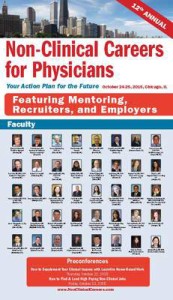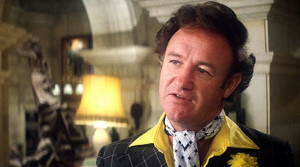 Over 400 physicians met in Chicago for the Non-Clinical Careers for Physicians Conference this weekend. We learned about dozens of jobs outside clinical care.
Over 400 physicians met in Chicago for the Non-Clinical Careers for Physicians Conference this weekend. We learned about dozens of jobs outside clinical care.
Many of you asked for more details. So I pulled most of the following information from the organizers.
I enjoyed it and would try to attend the pre-conference symposia next time.
Jobs at this conference included:
- Large International Pharmaceutical Company – Associate Medical Directors working in Pharmacology, Clinical Development, Medical Affairs, and Drug Safety (3 Full Time Positions)
- National Health Insurer– (16 Full time positions available including one work from home position)
- Niche Consulting Firm– Physician engineers (10 Full Time positions)
- Top National Insurance Company(1 Full time position)
- Top Research Based Biopharmaceutical Company( 1 Full time Position related to drug safety)
- National Medical Necessity Company(3 Full time positions)
- National Consulting Company(Many contractors needed to perform IMEs and Fitness for Duty Exams)
- National Peer Review Company(Looking to add 150-200 independent contract physicians to its roster each month)
- Physician Disability Consultants(Home based independent contractors)
- Workers’ Compensation Utilization Review Company(Up to 100 remote independent contractors wanted)
Non-Clinical Careers Conference
After cornerstone lectures with the whole group on the first morning, 35-40 recruiters, mentors and coaches each introduced themselves from a packed podium. We stampeded after them to book appointments over the next two days.
Then we picked lectures that ran concurrently over the remaining day and a half. Check out the main link for the schedule.
We learned about many of the following jobs, including training, time required, pros, cons and remuneration:
- Academia/Teaching
- Administration
- Author
- Blogger
- Business Owner
- Clinical Research/Development
- Coaching
- Communications Specialist
- Compliance
- Consulting Firms
- Contract Research Organizations (CROs)
- Disability Consultant
- Drug Safety/Pharmacovigilance
- Education
- Entrepreneur/Business owner
- Expert Witness/Litigation Support
- Federal Government
- Financial Planner
- Healthcare Advocate
- Health Guidance Organization Medical Director
- Health Insurance
- Hospice Medical Director
- Grant Reviewer
- Informatics/Heath Care Information Technology
- Insurance Free Medical Practice
- Journalist/TV Reporter
- Leadership Development
- Life Insurance
- Market Medical Director
- Medical Communications
- Marketing Consultant
- Medical Device Company Medical Director/Consultant
- Medical Director
- Medical Ethics
- Medical Marketing
- Medical Science Liaison
- Non-Profits
- Peer Reviewer
- Pharma (Industry)
- Physician Advisor
- Physician Executive
- Physician Training
- Portfolio Career
- Provider Network Medical Director
- Public Health
- Regulatory Affairs (Pharma)
- Software Developer
- Solo Consulting
- Speaking
- Staff Physician
- Utilization Reviewer
- Wellness
- Writing (Freelance)
Lectures on career cycles and change resonated with the audience (MD career cycles). But as mentioned above, >75% of the conference focused on physicians in different industries.
Some participants complained. They seemed to expect a job fair. But most people said they never expected so many doctors and so many jobs. I got what a hoped for, a scan of non-clinical careers.
Let’s hope government pays attention before too many doctors discover opportunities outside Medicare.


